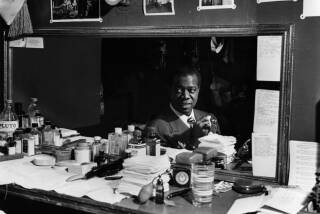It’s jazz piano trio meets rock power trio
The three musicians who call themselves the Bad Plus don’t look like revolutionaries.
Pianist Ethan Iverson, with his carefully trimmed goatee and rectangular-shaped glasses, could easily pass for a doctoral student in nuclear physics.
Shaven-headed drummer Dave King and shaggy haired bassist Reid Anderson present less establishment-oriented demeanors. But they appear, nonetheless, far more likely to have been Howard Dean foot soldiers than radical visionaries.
Yet the release of “These Are the Vistas” -- the Bad Plus’ first CD for a major label, Columbia -- triggered an astonishing array of praise last year. Esquire magazine, suggesting paradigm-shifting powers, asked, “Can one album single-handedly make jazz relevant again?” and answered the slightly skewed question in the affirmative.
“Give,” the trio’s second album, was released March 9. The new work expands both the territory and the interpretations present in the group’s first album via eight originals and cover versions of Ornette Coleman’s “Street Woman,” the Pixies’ “Velouria” and Black Sabbath’s “Iron Man.” The cover tunes -- fascinating deconstructions that reshape the material -- probably will receive the greatest attention. But the originals, ranging from surprisingly rhapsodic passages and jaunty country-style rhythms to the slightly musty, Latin feeling of a piece such as “And Here We Test Our Powers of Observation,” are every bit as compelling.
Favorable response to “Give” has already begun, with Rolling Stone describing the CD as “moving, mighty music -- bad in all the right ways” and England’s Observer noting how “they barge in and do things a piano trio aren’t supposed to do.”
That’s high praise -- and high expectations -- for musicians who seem to have sprung on the scene virtually out of nowhere.
Still not widely known last May when they performed at UCLA’s Jazz and Reggae Festival, they were initially greeted with quiet curiosity by a large crowd of listeners at Drake Field.
But as soon as the trio dug into the music -- featuring tunes by rock forces Black Sabbath, the Pixies and Blondie -- the crowd seemed galvanized by King’s rock-inflected drumming and Iverson’s electrifying, two-handed piano chording. Fans rushed to the edge of the stage in pure rock concert fashion.
It was a scene that was frequently repeated at the Bad Plus’ more than 100 performances in 2003.
King, whose ebullient conversation parallels his busy drumming, recalls the performance as an affirmation of the music’s power. “Improvised music, however complicated, has to believe that it can reach anyone who is in the room,” he says. “Too much jazz performance energy has suffered in almost like a joylessness bubble. It’s become very academic. That way of thinking does not enter our area.”
The Bad Plus’ growing visibility has placed the group among the potential leaders of what might be called the Nu Jazz movement -- an eclectically blended, acoustically framed, dynamically powerful variation on mainstream jazz.
Different in emphasis and sound from efforts -- by Branford Marsalis, Roy Hargrove, Russell Gunn and others -- to combine rap, hip-hop and turntabling with jazz, it is a movement that has been around the fringes for years, now coming into the wider view via the presence of the Bad Plus.
A few of the numerous other performers in this still loosely defined aggregation: saxophonist Chris Speed’s group Yeah No, saxophonist Ken Vandermark’s bands, bassist William Parker’s groups, drummer Bobby Previte’s ensembles, King’s other band Happy Apple, drummer Jim Black’s group AlasNoAxis, pianist Jean-Michel Pilc’s trio, as well as somewhat better established names such as trumpeter Dave Douglas, saxophonists Sam Rivers, John Zorn and Tim Berne, and keyboardists Vijay Iyer, Jason Moran and Uri Caine. All are different, blending cross-genre elements in their own unique fashions. Some stress an interface with contemporary pop, some do not.
Many trace their roots to Manhattan’s creatively fertile, downtown, out-of-the-box jazz scene, although the Southland has its own Nu Jazz pioneers in figures such as violinist Jeff Gauthier, drummers Alex Cline, Scott Amendola and Gregg Bendian, guitarist Nels Cline and veteran avant-gardist Vinnie Golia. All appear to have the principal goal of transforming jazz in a fashion that reaches beyond mainstream, beyond electric jazz, beyond fusion, and into the 21st century.
Big sound, big label
But the Bad Plus’ out-front, big label visibility has also made them an easy target for critical potshots from both jazz and pop directions.
The targeting is based upon the trio’s most immediately identifiable aspects: first, their decision -- despite their acoustic orientation -- to perform at volume and intensity levels usually associated with rock music; second, their frequent inclusion of cover versions of recent pop songs. (As with all successful white jazz groups, the issue of race is also present -- the risk that the Bad Plus will be viewed as, say, the Vanilla Ice of jazz.)
The trio’s high live decibel level has been reproduced on their CDs in startling fashion by producer-engineer Tchad Blake, whose larger than life sound has also graced albums by Pearl Jam, Elvis Costello, Tom Waits and others. In the April edition of Jazz Times, in a three-part story examining the group’s perceived plusses and minuses, critic Bill Milkowski (taking the naysayer role) writes, “Never before in the history of jazz (or even pseudo-jazz) has a band played so little so loud for so many and gotten so much -- hype, that is.”
Milkowski’s not the only one questioning King’s volume level. Yves Beauvais, who signed the group to Columbia, acknowledges that he initially had a “real problem” with the volume level of King’s drumming. But he also notes the vital role that the turbulent, backbeat-oriented percussion has played in reaching younger audiences.
“It’s a huge sound,” says Beauvais. “But it’s a sound that appeals to young listeners, because the Bad Plus sound so much like a rock ‘n’ roll band, even though what they play can be very complex. And that was certainly a large part of my interest.”
The decision to do covers of pop songs was -- on the face of it -- not particularly radical. Jazz musicians have always dipped into the music of their eras. The Bad Plus, however, have moved beyond the numbers in the Great American Songbook to pop tunes of the last two decades, pop tunes that have thus far had very little currency in the jazz world. “We have experience playing rock music,” says King. “We’re not just guys going, ‘Hey, let’s do a jazzy version of “Come As You Are” by Nirvana.’ We’re not thinking about how ironic it would be for us to do [Blondie’s] ‘Heart of Glass’ or [Black Sabbath’s] ‘Iron Man.’ This is music that we feel has a sense of power, music that can bring a little bit of that visceral, celebratory nature of a rock concert.”
Anderson, the group’s most calm and measured member, agrees. “There are plenty of acoustic groups in jazz that have played popular tunes,” he says. “But the standard approach has generally been to sort of ‘jazzify’ those tunes -- sand off the rough edges, make the tunes somehow more pristine. That’s never been our approach. If anything, we try to play the music even more raw -- jazz, yes, but jazz imbued with authentic rock energy.”
Anderson and King, both 32, have been working out their fascination with rock and jazz since they were teenagers in Minnesota. Although Iverson, 30, is from Wisconsin, he was jamming with Anderson before all three came together as a group in 1990. But he was a jazzer through and through, managing to avoid any youthful involvement with rock and pop music.
“I’ve always been off in my own little world,” he says. “But, as much as I loved jazz, I felt for years that there were things that had to happen in this music. And now with the Bad Plus all three of us feel as though there’s a lot of obvious stuff to do that hasn’t been done quite like this before. I don’t think it’s revolutionary, really. This isn’t some sort of paradigm shift, some change in language. But I think we’re doing some things that haven’t been done before.”
It remains to be seen whether Bad Plus’ “things that haven’t been done before” will be the guiding light into an authentic Nu Jazz genre. At the moment, Columbia is reporting “respectable sales in the 40- to 50,000 range” -- minuscule for a pop act, but considerably better than average for a jazz group, especially one newly arrived on the scene.
“Our expectations, our hope, before releasing the album,” Beauvais says, “was ‘Hmm.... Here’s a kind of left of center weird little jazz group with an unusual angle.’ We were hoping 10, 15, maybe 20,000 units if things went very well. So they’ve very much surpassed our expectations.
“But what I like best about the Bad Plus is the fact that their music is natural and honest. These guys grew up with funk, hip-hop and rock ‘n’ roll, as well as jazz, and embraced it all, without feeling contrived. And that’s the reason I hope to have them at Columbia for a long time.”
More to Read
The biggest entertainment stories
Get our big stories about Hollywood, film, television, music, arts, culture and more right in your inbox as soon as they publish.
You may occasionally receive promotional content from the Los Angeles Times.








